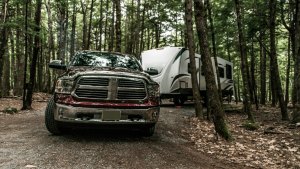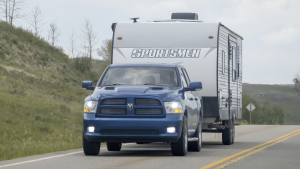One of the most common questions people ask before towing a camper, travel trailer, or fifth wheel is: Will my truck be able to tow it? Or what kind of truck do I need to safely haul it?
There’s a ton of confusion out there, and unfortunately, a lot of bad advice floating around, too.
I want to quickly break down what actually matters when it comes to pairing your truck with a trailer, without relying on vague internet comments or “bro science.”
Payload: The Most Commonly Ignored Number
Payload is how much weight your truck can carry inside and on it, not behind it. This includes passengers, gear, and most importantly, tongue or pin weight from the trailer.
This number varies widely by trim, drivetrain, cab style, and engine choice. In most half-ton pickups, a gas engine leaves more payload because the lighter powertrain lets the existing springs, axles, and tires carry more; in many three-quarter- and one-ton models, diesel versions keep similar, or sometimes higher, payload because the heavier engine comes with uprated suspension and axle parts.
Let’s say your half-ton truck has:
- 1,500 lbs of payload
- 11,000 lbs tow rating
Now add:
- Dad (200 lbs), Mom (150 lbs), two kids (200 lbs), and a dog (50 lbs): 600 lbs
- Gear in the bed: 100 lbs
- Weight distribution hitch: 75 lbs
That leaves 725 lbs for hitch weight. A trailer with a fully loaded weight of 8,200 lbs could easily have 820 to 1,230 lbs of tongue weight (10% to 15%). You’re now over payload, even though you’re under tow rating.
Tow Rating Isn’t Everything
Tow capacity is usually the first number people look at. It’s often front and center in truck ads. But it’s not the full story. It’s more of a starting point. Tow ratings are based on a truck with minimal passengers, no gear, and perfect conditions.
If your truck is rated to tow 11,000 pounds, that doesn’t mean it can safely pull an 11,000-pound trailer after loading it up with people, gear, and fuel.
Gross Combined Vehicle Weight Rating (GCVWR)
GCVWR is the maximum total weight your truck and trailer can legally weigh together when fully loaded. It includes everything in the truck, plus the trailer and everything in it.
This number is set by the manufacturer and is usually listed in the owner’s manual, towing guide, or official spec sheet. It’s not always printed on the door sticker like GVWR.
GCVWR is not just GVWR plus tow rating. Manufacturers calculate it based on how the truck performs under load, taking into account things like braking, cooling, frame strength, and axle ratings.
If your loaded truck and loaded trailer together weigh more than the GCVWR, you’re over the truck’s rated limits, even if you’re under the tow rating or GVWR individually.
Axle Ratings
Every truck axle has a limit. If too much weight is placed on a single axle, you’re putting stress on components that weren’t built for it. A weight distribution hitch can help spread that load more evenly across the front and rear axles, as well as the trailer’s axles.
Add-Ons Don’t Change Ratings
People often think they can “upgrade” their truck’s capacity with things like:
- Airbags
- Stiffer springs
- Aftermarket shocks
These can help level the ride or make it feel more stable, but they do not increase payload, tow capacity, or axle ratings. In fact, they add weight, reducing available payload.
To legally increase your weight ratings, you’d need to go through an expensive recertification process and get a new compliance sticker issued under federal guidelines. That’s not something most people will do.
Stopping Power Misconceptions
There’s a popular saying: It’s not about what you can tow, it’s about what you can stop. It sounds smart, but braking ability is already factored into a truck’s weight ratings.
If you stay within those limits and your trailer has functioning brakes (as required by law on heavier trailers), the truck is designed to handle it. If you’re overloaded and can’t stop, the problem isn’t the truck it’s the setup.
Leave a Safety Margin
You don’t want to ride right at the edge of your truck’s weight ratings. Many people suggest staying below 75% to 80% of your truck’s capacity for regular towing. That way, you’re not maxed out when driving through headwinds, climbing hills, or making emergency maneuvers.
Towing Confidence Isn’t a Specification
Some folks say things like:
- “It pulls like it’s not even back there.”
- “I tow this all the time without issues.”
- “It’s a diesel, so it’s fine.”
None of that replaces real numbers. A truck might feel fine towing an overloaded trailer until something goes wrong. Your goal is to be within the ratings the truck was tested and certified for not to rely on gut feeling or one-off success stories.
Fifth Wheels Need Different Math
If you’re towing a fifth wheel, you’ll need to calculate pin weight instead of tongue weight. And the weight on the rear axle of your truck could easily be 20% to 25% of the trailer’s total weight. This eats into your payload quickly.
Check Tire Load Ratings and Pressures
Every tire has a load index number (or, for LT tires, a load range like C, D, or E) that tells you how much weight it can carry at a specific cold inflation pressure. To make sure your tires are rated for the actual weight on each axle:
- Read the sidewall
Look for the load index or load range marking. - Use a load-inflation chart
Match the tire’s load rating to its cold pressure using the manufacturer’s official chart. - Add the axle total
The combined rating of both tires on an axle must meet or exceed the axle’s GAWR and the actual weight measured on a scale. - Adjust for P-metric tires
If your truck has P-metric (passenger) tires, reduce their listed load capacity by 10% when used on a light truck or SUV. - Inflate based on load
Inflate tires to the cold pressure needed for the actual load, but never above the max pressure shown on the sidewall. - Check the pressure before every trip
Temperature swings and elevation changes can impact cold pressure. Always check before hitting the road.
A tire that’s under-inflated for its load or overloaded for its rating can build heat quickly. That heat can lead to tread separation or a blowout before you have any warning.
Use a Brake Controller
If your trailer is equipped with electric brakes, you’ll need a compatible brake controller installed in your truck. These are legally required in most states for trailers over a certain weight (thresholds vary widely).
Suspension Sag Affects Safety
Too much weight on the rear of your truck can cause the headlights to aim upward and reduce braking control. A weight distribution hitch can help balance the load and improve driving conditions, especially at night.
Know Your State Laws
Towing laws vary by state. Speed limits, brake requirements, and trailer length restrictions aren’t the same everywhere. Before crossing state lines, it’s worth checking the towing laws for each state you’ll pass through.
Transmission Cooling
Many trucks list a higher tow rating only when ordered with the factory tow package, which includes a larger transmission cooler. If your truck lacks that package and you tow near the upper end of the ratings, fluid temperatures can climb quickly on grades or in summer heat. Consider an aftermarket cooler that matches factory specs and use the transmission temperature readout (if equipped) to keep an eye on it.
Weigh Your Setup
After you’ve picked a truck and trailer, head to a certified CAT scale to get real numbers. Weigh the truck, the trailer, and the combined rig. This confirms you’re within the specs and gives peace of mind before long hauls.
Final Thought
Your truck’s limits aren’t just suggestions. They’re based on engineering, safety testing, and legal standards. Towing safely means knowing the numbers and staying within them. Not guessing. Not eyeballing. Not hoping.
Know your rig. Know your weights. Know your limits.







We are looking to buy a Keystone Cougar Sport 5th wheel, either a 2100 or 2400 model. We know that our new Tundra Hybrid can haul the 2100, but it doesn’t have the amenities that the 2400 has. The 2400 is 7474 dry weight lbs. Our truck has a limit of 11,300 lbs. We think that 7474 lbs. with 2000 for liquids/supplies and passengers should be okay. Is there anyone that has experience with this same setup? ? (We had a 3500 Dodge Ram diesel with only 9,000 miles, and we traded it in on the Tundra because we never used it and it was so huge. It was also a gas hog and expensive to drive. So, please don’t recommend that we buy a bigger truck!) Hoping that the 2400 model is okay… Also, our Tundra is not a long bed. Does this make a difference?
Hi Tina, what’s the payload rating for your Tundra?